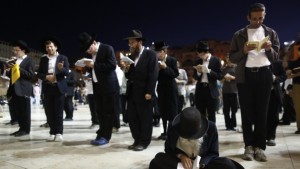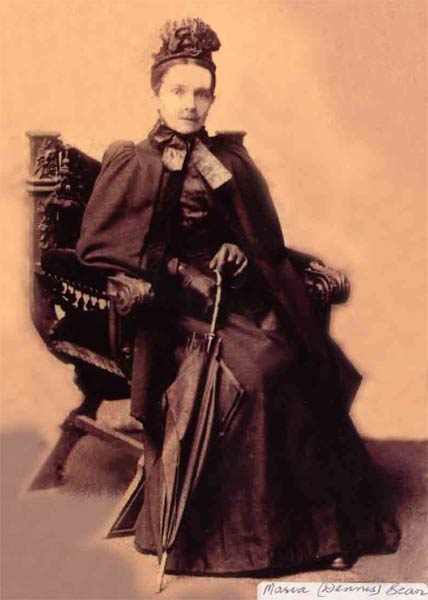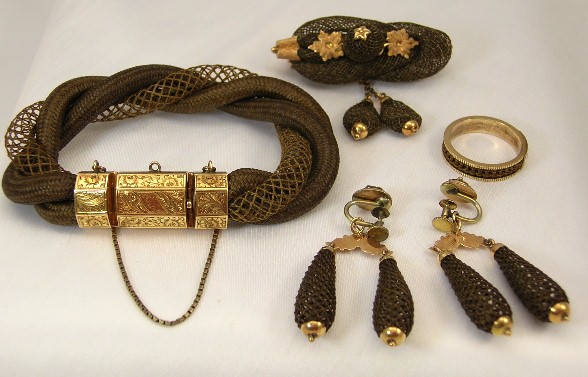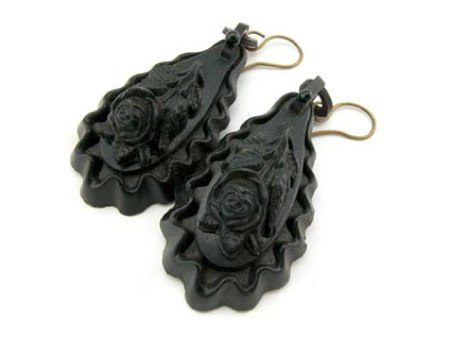A couple months ago I had the unfortunate call to attend the funeral of my former coworker’s 20 year-old daughter who tragically died — of all unlikely things in a developed country — during childbirth. In dressing for the funeral, I selected a lovely black taffeta dress with an outer layer of sheer black tulle with long tulle sleeves. In spite of its elegance (it’s a Lilith sample my friend, a former employee of that Parisian label, gave me), I actually don’t wear it very frequently because it’s a lot of black and I think it makes a morbid statement, especially paired with my pale skin; however this quality made it ideal for my sad errand.
As I was putting the finishing touches on my toilette — I accessorized with a dripping black tasseled necklace — my partner asked if I really wanted to be so fancy. “Of course,” I replied, “it’s a funeral. You’re supposed to dress up to show your respect.” Both of us a little puzzled by the other’s expectations of appropriate mourning dress, we resumed the conversation later.
My guy is accustomed to Jewish traditions including the kriah (or keriah), where mourners tear a rent in their clothes which they display for the 7 days of shiva, the intense mourning period following a death. The specific placement of this tear is determined by the relationship with the deceased: for a parent, the visible rip is on or near the heart; for siblings, children and spouses, the rip is on the right and need not actually be visible. Children of the deceased are not allowed to ever mend the tears they make, even when shiva has ended, whereas all other mourners may patch the holes after shoshim, the 30 days following a death. Straight away, a hierarchy of relationships is established by the clothes. That of the parent and child is given precedence — even over spouses — in a stylized demonstration of respect and perhaps obligation more than an implied closeness of personal relationship, which I found interesting.
Kriah is traditionally ripped while standing (to show strength in a time of grief) and the following blessing is recited: Barukh atah Adonai Eloheinu melekh ha’olam dayan ha’emet. Translation: “Blessed are You, Adonai Our God, Ruler of the Universe, the True Judge.”
Nowadays, a torn kriah ribbon, pinned in the appropriate location, is sometimes substituted for an actual tear in mourners’ clothes:
The Biblical roots of the kriah include when Jacob believed his son Joseph was dead and he tore his garments (Genesis 37:34). Likewise, King David and all his men rent their clothes upon hearing of the death of Saul and Jonathan (II Samuel 1:11). Job, too, in grieving for his children, stood up and rent his clothes (Job 1:20).
The kriah is a visual representation of the tear in the hearts and lives of the bereaved, or alternately, a vent to release grief. It also signifies that it is only the outer garment (representing the body) that has been torn; the soul of the deceased and the love that the deceased and the mourners have for each other endures. Furthermore, vanity in times of mourning is viewed as disrespectful — the bereaved should be focused on internal, soulful emotions and not outward public appearance. To this end, bathing, changing clothes, haircuts and nail clipping are also suspended, and to avoid temptation of pride, mirrors are covered.
The final rule of self-presentation during shiva (which also applies for Yom Kippur, the Day of Atonement) is that leather shoes may not be worn. I was initially perplexed (as were several Jewish friends I asked, and many many people on the internet) as to the reasoning behind the ban on leather shoes in times of mourning. I understand that going without shoes is a powerful display of the rejection of physical comfort, but why would leather be specified? Sneakers, flip-flops or Crocs would circumvent the no-leather shoes rule but wouldn’t make sense if shunning comfort were the sole object (tee hee). Have no fear, Reader on the edge of your seat — I did find a plausible explanation.
First (and unsurprisingly), foregoing leather shoes to show deference has roots in the Torah: Moses removed his leather shoes (or sandals, as the case probably was) to approach the burning bush (Exodus 3:5), Joshua did as well when he faced the angel at the Promised Land (Joshua 5:15), and Ezekiel was commanded to remove his shoes while in mourning (Ezekiel 24:17). In these cases, the object was to show deference to God, but during shiva I imagine that that reverence is transferred to the departed. These were not demonstrations of deliberate discomfort so much as those of humility. A secondary explanation is that leather used to be far more of a luxury item than it is today (though there are clearly still traces of this high end market remaining). Leather shoes, then, fell into the category of jewelry and general adornment too ostentatious for times of ritualistic despair. The third reason for the leather shoes ban is one of sensitivity. “This is a day that we are not to practice violence and to look for compassion in life,†says Rabbi Jay Rosenbaum of the Herzl-Ner Tamid Conservative Congregation. “But to get the leather that would be used to make shoes would mean killing one of God’s creatures.”

Orthodox Jewish men pray as they gather for the mourning ritual of Tisha B’Av– when Jews mourn the destruction of the biblical temples– at the Western Wall in Jerusalem. Not the cloth and plastic shoes.
For Jews, distressing their appearance is a physical manifestation their distressed emotional states, which I find perfectly poignant, though it runs contrary to the Christian practices and ideologies I grew up with. Brought up Episcopalian (the WASP version of Catholic), we had a very different set of rituals surrounding death and mourning. A particularly complex and rigid set of rules and customs were solidified during the Victorian era.
After the death of England’s Prince Albert in 1861, the devastated Queen Victoria decreed a 40 year mourning period that was to be observed by all in an elaborate and conspicuous manner. The dress codes relating to the royal death trickled down and were adopted by the church, to be followed for all subsequent (Christian) deaths. Dark, somber clothes were demanded by all affected by the death. Widows endured the most elaborate dress rules and for the longest period of time. They were to wear black dresses made of crepe (a dull, lusterless material) with black caps which were generally in simpler versions of the current style. Topping the costumes were long “weeping veils” which were sheer crepe or silk. All widows’ accessories were black as well, including parasols, gloves, and stockings (undergarments were exempt because color-fast dyes had not yet been perfected and black would rub off on wearers’ bodies).
“Full mourning” lasted a year-and-one-day for widows, after which they could graduate — slowly — to lighter, brighter colors, but only by prescribed degrees. Grays and deep purples were acceptable in “half mourning,” and after 2 years or so a normal, fashionable pallet was once again acceptable. Additionally, widows were not to participate in society — that is, balls, social gatherings, and essentially any public event except church — for 3 months, after which they could go out in public but only in full mourning garb. When a widow appeared in fashionable colors again, it was essentially an announcement to the community that she was available for courting and remarriage, which was usually a financial necessity.
Scarlett O’Hara famously disregards this tradition in the Gone with the Wind (1939) ball scene where she flouts propriety, not by her clothes (which she complains about loudly but wears), but by dancing publicly, an act of frivolity distinctly unbecoming of a widow.
At the ball, having accepted the inappropriate invitation to dance with Rhet Butler:
Rhet: “We’ve sort of shocked the Confederacy, Scarlet.”
Scarlett: “It’s a little bit like blockade running, isn’t it?”
Rhet: “It’s worse!”
Here is a clip where you can hear the gasp of the shocked ball attendees when Rhet publicly bids for a dance with supposedly grieving Scarlett (her Aunt Pitty actually faints!). Fast-forward to 0:53:
Here is a properly dressed widow, accessories and all:
Christians, like Jews, downplay personal adornment while mourning, though not as completely. Jewelry may be worn, but it must be dark and possess little or no sheen. Several unusual materials became popular during the 19th century due to their possession of these qualities.
The hair of a beloved or recently deceased was often intricately woven into “chains” and “beads” to be worn by the bereaved:
Queen Victoria’s obsession with the public mourning of Prince Albert resulted in a great demand for fashionable and affordable black jewelry, and jet became a popular material for jewelry and buttons. It is an incredibly dense, dark mineraloid derived from decaying wood, appropriately enough. It has been imbued with a religious significance too, as it is a traditional material for monks’ rosaries. Queen Victoria sported and popularized Whitby jet, which initially created a boom in the industry but hampered its long term usage, as people then associated the stone with death. Vulcanite was another material of similar properties commonly used for mourning jewelry.
Compare the left shiny buttons below, suitable for everyday wear, to the matte version on the right, acceptable for mourning:
As in the Jewish custom, levels of Victorian observance were determined by relationship to the deceased, but this was marked more by length of time in mourning dress than by placement of a specific mourning emblem. Grieving men initially wore simple black suits and black armbands. Servants wore black armbands, as could men who were obliged to wear military uniforms. Children usually wore white with black trim in summer and gray with black trim in winter; they were to observe full mourning for 9 months and half-mourning for 3 more (this was the same timeframe parents followed). Siblings observed full- and half-mourning for 3 months each. Unlike Jews, who place the heaviest mourning obligation on surviving children, (Victorian) Christians emphasized the spousal relationship by cloaking the widow in the most elaborate costume and for the longest period of time, that was synced with her ultimate marital / sexual availability.
You can see that though the Victorians had strict rules regarding color (or lack thereof), materials, and textures / sheen, mourning clothes were still expected to be fashionable and decorative, a major departure from the Jewish tradition. Some of the differences may be related to the belief or disbelief in an afterlife. Christians, though grieving for their own losses, are supposed to rejoice that their loved ones have passed from this mortal world to the next heavenly one. Jews have no such idealistic post-death haven to temper their sorrow, so it follows that the mourning dress should be plainer and less celebratory. Relating to this theory is another Jewish tradition pertaining to the attire of the deceased themselves. After being washed, the body is dressed in tachrichim, hand sewn linen clothes. There are no pockets, as Jews believe we take nothing with us when we die, and everyone buried in identical robes symbolizes that all people are equal (this is reinforced by identical, plain pine caskets).
I love how costume has been utilized as a mourning tool in such different ways. I think there’s something very beautiful and appealing about all these rituals: they are both intended to demonstrate respect for the dead, comfort those left behind, and eventually assist the bereaved to return to normal life. Silly or excessive as either may seem, don’t we all crave those things in trying times?
************************************************************************
Since working on this post, my own uncle passed away (this is why it’s been so long since I posted last). Though I’m not particularly religious, I did wear black for a week. This was not intended to be a signal to others (black garb is too commonplace to stand out anymore anyway) but as my own private gesture of deference and sorrow, using the language I express myself with: clothes. I dedicate this entry– as a fully inadequate demonstration of my own love and loss — to Uncle Dick.
Further reading:
- “Shoeless in the Sanctuary,” Dr. Yoel Shiloh
- “Mourning,” with more specific Biblical references, from the Jewish Encyclopedia
- JewishFunerals.org
- “Victorian Mouring Garb,” Morbid Outlook




































2 comments
sed says:
Feb 27, 2018
hi there
is there a custom that a jewish widowe should wear white in funeral ?
Peny@custom digitizing says:
Sep 21, 2011
Traditions vary in forms, yet what I see in these traditions and different cultures is the similarity of its essence of mourning for who was lost and the memory they had left.